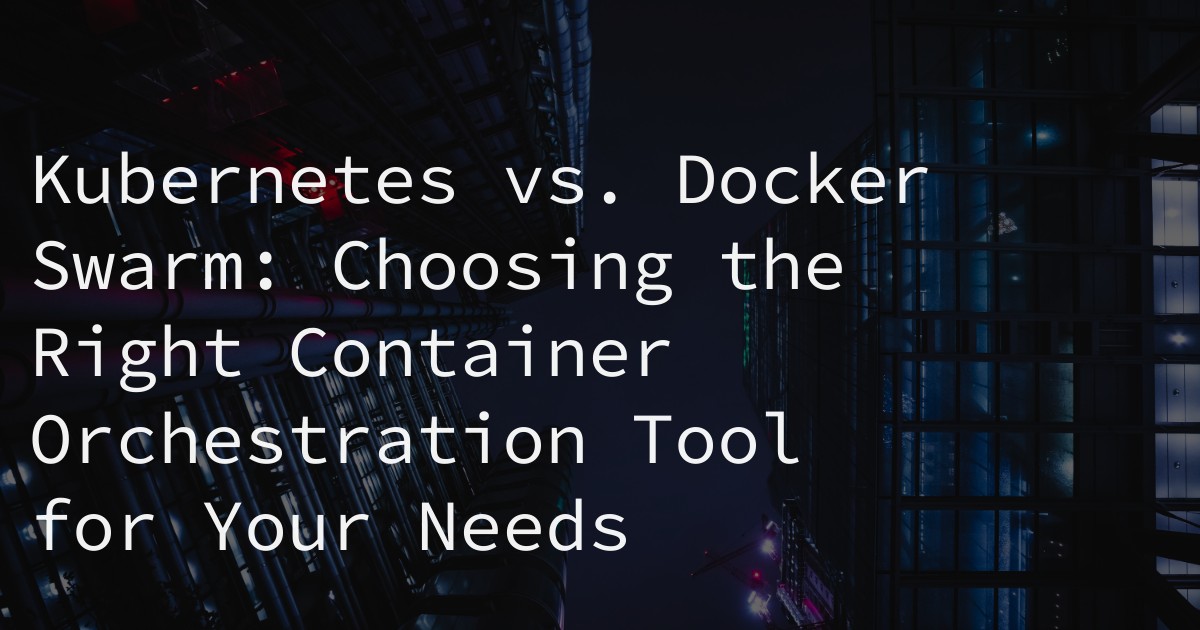
31 Oct Kubernetes vs. Docker Swarm: Choosing the Right Container Orchestration Tool for Your Needs
Container orchestration has become an essential aspect of cloud computing, allowing organizations to efficiently manage and deploy their applications. With the rise of containerization, tools like Kubernetes and Docker Swarm have emerged as popular choices for container orchestration. However, choosing the right tool for your needs can be a daunting task. As a SEO and Cloud Computing expert, I will provide a comprehensive guide to help you make an informed decision between Kubernetes and Docker Swarm.
Understanding Kubernetes and Docker Swarm
Kubernetes and Docker Swarm are two popular container orchestration tools that have gained significant traction in the market. While Kubernetes was originally developed by Google, Docker Swarm is a native feature of the Docker platform. Both tools have their own strengths and weaknesses, making it crucial to understand their differences before making a decision.
When it comes to architecture, Kubernetes follows a master-slave model, where the master node manages the cluster and the worker nodes run the containers. On the other hand, Docker Swarm uses a leader-follower model, where the leader node manages the cluster and the worker nodes run the containers. Both tools have similar key components such as pods, services, and volumes, but differ in their implementation.
One of the main differences between Kubernetes and Docker Swarm is their popularity and adoption in the market. While Kubernetes has a larger community and is widely used in production environments, Docker Swarm is known for its simplicity and ease of use, making it a popular choice for smaller deployments and simple use cases.
Choosing the Right Tool for Container Orchestration
When it comes to choosing between Kubernetes and Docker Swarm, there are several factors that need to be considered. These include your organization’s needs and requirements, scalability and performance considerations, availability of resources and expertise, and cost considerations.
If your organization requires high scalability and availability, Kubernetes would be the ideal choice. It also offers robust features for managing and deploying containers, making it suitable for complex and large-scale deployments. On the other hand, Docker Swarm is a better option for smaller deployments and simple use cases, as it is easy to use and learn, and has low resource consumption.
Benefits of Kubernetes
- High scalability and availability
- Robust features for managing and deploying containers
- Support for multi-cloud and hybrid environments
- Strong community support and continuous development
- Integration with other tools and platforms
Benefits of Docker Swarm
- Easy to use and learn
- Low resource consumption
- Native integration with Docker
- Suitable for smaller deployments and simple use cases
- Less complex setup and deployment process
Challenges of Kubernetes
- Complexity and steep learning curve
- Requires a dedicated team for management and operations
- Limited support for Windows containers
- Higher resource consumption compared to Docker Swarm
- Regular updates and maintenance required
Challenges of Docker Swarm
- Limited scalability and availability features
- Lack of advanced container management capabilities
- Not suitable for complex and large-scale deployments
- Dependency on Docker for updates and maintenance
Choosing the Right Tool for Your Needs
Ultimately, the decision between Kubernetes and Docker Swarm depends on your organization’s needs and priorities. It is important to evaluate the benefits and challenges of each tool and choose the one that aligns with your requirements. It is also worth noting that both tools can coexist in an organization’s infrastructure, providing flexibility to switch between them based on evolving needs.
Conclusion
In conclusion, choosing the right tool for container orchestration is crucial for the success of your cloud computing strategy. While Kubernetes and Docker Swarm have their own strengths and weaknesses, it is important to carefully consider your organization’s needs and requirements before making a decision. With this comprehensive guide, I hope you are now equipped to make an informed decision between these two popular container orchestration tools.
RELATED ARTICLES:



Sorry, the comment form is closed at this time.